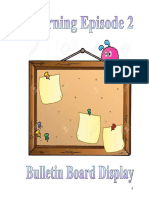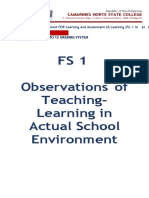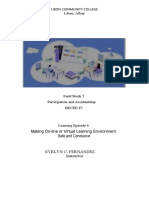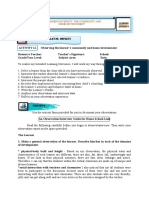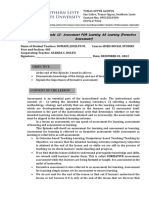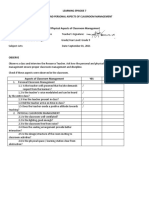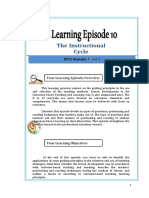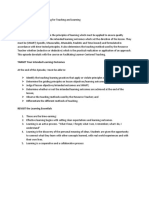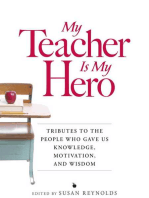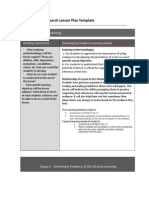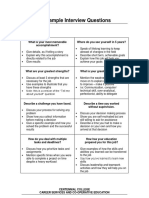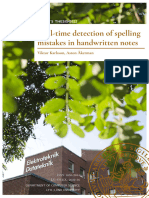Fs 1 Episode 11
Fs 1 Episode 11
Uploaded by
Bembem DelfinCopyright:
Available Formats
Fs 1 Episode 11
Fs 1 Episode 11
Uploaded by
Bembem DelfinOriginal Title
Copyright
Available Formats
Share this document
Did you find this document useful?
Is this content inappropriate?
Copyright:
Available Formats
Fs 1 Episode 11
Fs 1 Episode 11
Uploaded by
Bembem DelfinCopyright:
Available Formats
lOMoARcPSD|33940919
FS 1 Learning Episode 11
BS Secondary Education (Cotabato State University)
Scan to open on Studocu
Studocu is not sponsored or endorsed by any college or university
Downloaded by alex delfin (alexdelfin2002@gmail.com)
lOMoARcPSD|33940919
FIELD STUDY 1 LEARNING EPISODE
Utilizing Teaching- Learning
FS 1 11 Resources and ICT
SPARK Your Interest
With the lightning speed by which technology is evolving, and now with 4.0,
technology continues to be an ever significant part of the learning environment. This
episode provides an opportunity for students to examine a Learning Resource Center or
Multi-Media Center and learn about its collection, services, equipment, observe how a
teacher utilizes technology for instruction, and explore resources in the virtual learning
environment. Students will analyze and reflect on how technology, including artificial
intelligence, supports the teaching-learning process.
TARGET Your Intended Learning Outcomes
At the end of this Episode, I must be able to:
identify and classify learning resource materials in the multi-media center;
show skills in the positive use of ICT to facilitate the teaching-learning process
(PPST 1.3.1);
show skills in the evaluation, selection, development, and use of a variety
learning resources, including ICT to address learning goals (PPST 4.5.1);
analyze the level of technology integration in the classroom; and
demonstrate motivation to utilize ICT for professional development goals based
on the PPST (PPST 7.5.1).
REVISIT the Learning Essentials
UNESCO ICT Competency Framework for Teachers Version 3 (ICT CFT v3, 2018)
The Information and Communications Technology Competency Framework for
Teachers (ICT CFT) version 3 is a comprehensive framework guide teachers’
development on the effective and appropriate use of ICT in education. It highlights what
teachers should know and do clustered in six aspects, namely; 1. Understanding ICT in
Education, 2. Curriculum and Assessment, 3. Pedagogy, 4. Application of Digital Skills,
5. Organization and administration, and 6. Teacher Professional Learning.
Similar to the PPST, the ICT CFT also articulated competencies in levels which
guide teachers as they develop their ICT skills from Level 1, Knowledge Acquisition, to
Level 2, Knowledge Deepening, and Level 3, Knowledge Creation. The Commission on
Higher Education Teacher Education Curricula (2017) includes the UNESCO ICT CFT
so most likely you have tackled this in your Technology for Teaching and Learning
classes.
Downloaded by alex delfin (alexdelfin2002@gmail.com)
lOMoARcPSD|33940919
It will be good to review the UNESCO ICT CFT v3 framework as you work in this
episode. The activities here are meant for you to observe, analyze, and reflect about the
competencies discussed in the framework. (Access it at
https://www.open.edu/openlearncreate/pluginfile.php/306820/mod_resource/content/2/U
NESCO%20ICT%20Competency%20Framework%20V3.pdf)
The Learning Resource Center
1. A school usually sets up a center that will provide valuable support to the
teaching-learning process. Over the years the name of this center has evolved.
Some of the names are Audiovisual Center, Media and Technology Resource
Center, Teaching-Learning Technology Department, or Simply Learning Resource
Center.
2. With the swift development of ICT, the natural outcome was the ever-expanding
interface between the traditional library and ICT both in terms of hardware and
software systems and applications.
3. Schools may have different set-ups when it comes to a Learning Resource
Center (LRC). Some have replaced the term library with LRC. Some have
separate library, LRC, and Audio Visual or Media Center. Some only have the
LRC both for teachers and students. Still some have combined their learning
resource centers with maker spaces.
4. The common purpose among these centers is to provide print, audio-visual and
ICT resources to support the teaching-learning process
5. The goals of the Center may include orienting and training teachers in the use of
audiovisual and ICT resources, working with teachers and administrators in
producing instructional materials, making available useful resources to the
students, teachers, and the school community.
6. In order to support the philosophy and aims of the school, the Center must fulfill
the following functions: center of resources, laboratory of learning, agent of
teaching, service agency, coordinating agency, recreational reading center, and a
link to other community resources.
Technology Integration
The Technology Integration Matrix provides a comprehensive framework for
you to define and evaluate technology integration. It will provide you direction and guide
you in the process of achieving effective teaching with technology. The teacher’s
integration of technology in instruction can be described as progressing in 5 levels:
entry, adoption, adaptation, infusion, and transformation.
The teacher also works at creating a learning environment that encourages and
enables quality technology integration. The interdependent characteristics of the
learning environment are being active, collaborative, constructive, authentic, and goal-
directed.
The Technology Integration Matrix connects the Level of Technology Integration
and the Characteristics of the Learning Environment. Examine the matrix below. To
Downloaded by alex delfin (alexdelfin2002@gmail.com)
lOMoARcPSD|33940919
make you understand how integration is done in each of the levels and environment,
explore the TIM website and learn from the many interesting videos showing technology
integration. Go to http://fcit.usf.edu/matrix/matrix.php
Observing technology integration in the classroom
(Reproduced with permission of the Florida Center for Instructional Technology,
College of Education, University South Florida, fcit.usf.edu)
Evaluation of ICT Resources
The world wide web is like an endless network of information,ever- expanding
and almost limitless. Electronic resources come in different forms like websites,
webquests, blogs, social network sites, on-line courses, a wide range of tools, and so
many forms of apps.
As a future teacher, one of the skills that will be most useful for you is the ability
not only to search for information but to make decisions, as to which ones you will take
and use and which ones you will put aside. Aim to develop your skills in evaluating
internet resources. You will be able to choose the best resources that will help you attain
your teaching-learning objectives.
Below is a set of criteria which you can use to evaluate resources:
1. Accuracy. The resource material comes from a reliable source and is accurate,
free from error and is up-to-date.
Downloaded by alex delfin (alexdelfin2002@gmail.com)
lOMoARcPSD|33940919
2. Appropriateness. The resource is grade0level-appropriate. The content
matches what is needed by the teacher.
3. Clarity. The resource clearly addresses the instructional goals in mind.
4. Completeness. The content is complete. It has all the information needed to be
able to use them.
5. Motivation. The resource is engaging and rewarding to learners. It will
encourage the active participation of the learners.
6. Organization. The resource is logically sequenced. It clearly indicates which
steps should be taken. The procedures or processes flow smoothly.
(Based on the work of Fitzgerald, Mary Ann, Lovin, Vicky, & Branch, Robert Maribe
(2013). A Gateway to Educational Materials: An Evaluation of an Online Resource for
Teachersand an Exploration of User Behaviors, Journal of Technology and Teacher
Education. 11 (1), 21-51).
Education 4.0
Schwab described the 4th wave of the industrial revolution. The unprecedented
speed at which technology is evolving has disrupted many vital processes that involve
how we run production, business and consequently how we teach and learn. The
following Technology trends have huge potential to transform the ways we teach
and learn (UNESCO, 2018):
1. Open Educational Resources (OER). OERs are materials that can be used for
teaching and learning that do not require payment of royalties nor license fees.
There is an abundance of OERs in the form of textbooks course materials,
curriculum maps, streaming videos, multimedia apps, podcasts, and many
others. They can have a significant impact on education as they are made
available and easily accessible in the internet. Be sure to explore them to help
you work on this episode.
2. Social networks. Social networks have revolutionized the way we interact, learn
about things, and share information. Sites and apps such as Facebook, twitter,
Instagram provide a virtual venue for teachers and learners to work together
interact among themselves and with other classrooms locally and globally.
3. Mobile Technologies. Filipinos are one of the most active on the internet, and
also one who sends the most number of text messages per day. This indicates
the high number of mobile device users. These devices can be also be used as a
learning tool by allowing teachers and students more opportunities to learn inside
and even outside the classroom.
4. The Internet of Things. IoT is a system of computing mechanisms that become
built-in into many everyday things, that allow sending and receiving data through
the internet. A lot of things have turned “smart”. We have smart cars that can
navigate on its own. Smart houses that monitor temperature and light. Smart Tv’s
Downloaded by alex delfin (alexdelfin2002@gmail.com)
lOMoARcPSD|33940919
that interface with the internet. Watches that send our vital signs to our doctors.
All of these development can influence the way we teach and learn.
5. Artificial Intelligence. Commonly, artificial intelligence is associated when
computers or machine simulate thinking and behaviors of humans such as
talking, learning and solving problems. Virtual assistants such as Siri, Alexa,
Bixby and Google assistant are near samples of AI. Among others, uses of AI in
education can be in the areas of gamification and adaptive instruction for
learners with special needs.
6. Virtual Reality and Augmented Reality. VR is a simulation of an environment
by a computer program that allows a person to visit and experience the
environment virtually. In AR, images from computer programs interlay with the
actual views of the real-world, resulting in an extended, expanded, or altered
view of a real-world environment. In education, among others, VR and AR
programs and apps allow more exciting ways of seeing and experiencing things
that add to the motivation and engagement of learners.
7. Big Data. Through the billions of interactions and transactions are done
electronically, and through the internet, an enormous amount of data is
generated and stored. The challenge is how to make sense of this data, through
analytics and research, possibly answer pertinent questions about how to make
teaching and learning most effective.
8. Coding. Coding is a skill necessary to create computer software, apps and
websites. Today, there are learning programs that introduce coding activities as
early as kindergarten. Robotics programs in the elementary and secondary
programs introduce and hone the skills of young learners. Coding helps learners
develop novel ways of exploring and trying out ideas, especially when done with
problem or project-based learning approaches.
9. Ethics and privacy protection. We have repeatedly heard about how quickly
technology is changing and impacting our lives. Through all this, it is crucial to
ensure that human values and principles govern or guide our use of technology.
Ethical practices that protect the rights of every person need to be upheld.
Downloaded by alex delfin (alexdelfin2002@gmail.com)
lOMoARcPSD|33940919
Downloaded by alex delfin (alexdelfin2002@gmail.com)
lOMoARcPSD|33940919
Massive Open On-line Courses
Massive Open On-line Courses (MOOCs) are online courses open to a big group
of people. Below are the basic information about MOOCS. Let us focus in each word:
Massive
MOOCs are on-line courses designed for large number of participants, usually
larger than the number of students that can fit a regular classroom. There can be
hundreds or even be a thousand students or more.
Open
There is mostly freedom of place, pace and time.
Courses can be accessed by anyone anywhere as long as they have internet
connection.
Courses are open to everyone without entry qualifications.
Some courses are for free.
Online
All aspects of the course are delivered online.
Course
The MOOC course offers a full course experience including;
Educational content. May include video, audio, text, games, simulations,
social media and animation.
Facilitation interaction among peers. Builds a learning community through
opportunities to interact.
Some interaction with the teacher or academic staff
Activities/tasks, tests, including feedback. Participants are provided with
some feedback mechanism. Can be automatically generated like quizzes,
feedback from peers or the teacher.
Some kind of (non-formal) recognition options. It includes some kinds of
recognition like badges or certificate of completion. A formal certificate is
optional and most likely has to be paid for.
A study guide/syllabus. This includes instructions as to how you may learn
from the materials and interactions presented.
- Based on Definition Massive Open Online Courses v1.1 licensed under
Creative Commons Attribution 4.0
There are many MOOC provides like Edx, Coursera, Udacity, Udemy, Iversity. You will
have a chance to explore them as you go through this Episode.
Downloaded by alex delfin (alexdelfin2002@gmail.com)
lOMoARcPSD|33940919
OBSERVE, ANALYZE, REFLECT
Activity 11.1 Visiting the Learning Resource Center
Resource Teacher: __________ Teacher’s Signature:_________ School:___________
Grade Year Level: __________ Subject Area:_______________ Date:_____________
To realize the Intended Learning Outcomes, work through these steps:
1. Visit a school’s Learning Resource Center. Look around and see what
resources and facilities are available inside.
2. Ask the Learning Resource Center in-charge about how some equipment or
facilities are used.
3. Make an inventory of its available resources and classify them according to
their characteristics and functions.
OBSERVE
As you visit and observe the Learning Resource Center, use the observation
guide provided. Ask the assistance of the Center staff courteously.
An Observation Guide for a
LEARNING RESOURCE CENTER
Read the following statements carefully before you observe.
1. Go around the Learning Resource Center.
2. Find out what learning resources are present.
3. Examine and describe how the materials are arranged and how they are
classified. Are they free from dust and moisture? Are they arranged for easy
access?
4. Read the guidelines/ procedures for borrowing of materials. Are these
guidelines/procedures posted are available for the users to refer to?
5. Familiarize yourself with the guidelines and procedures. Take the photos of
the center (if allowed).
After you are through with your observation, classify the resources available that you
believe are most useful. Use the activity form provided for you.
Name of Center Observed: Dr. Cecilio Putong National High School
Date of Observation: _________________________________________
Name of Observer:
Downloaded by alex delfin (alexdelfin2002@gmail.com)
lOMoARcPSD|33940919
Course/Year/School:
List of Available Learning Resources
Available Learning Characteristics and Teaching Approaches
Resources Unique Capabilities where the Resource Is
(Enumerate in bullet form) Most Useful
1.Print Resources -Widens the vocabulary of Lecture - English textbooks
Textbooks the students. used by Filipinos are more
Reference books -improves reading skills advance compare to other
Journals and -good source of information counties in Asia.
magazines for the teachers.
2. Audio Resources -this helps to capture the Lecture - these resources is
Microphone attention of the students very helpful to add volume
Speakers even in big class size during lectures.
Headset/Earphone
3. Non-electronic Visual These traditional materials These resources are very
Resources are very basic and easily useful both direct and
Pictures attainable and available. indirect approaches of
White and These serves as partners instructions being used by
Blackboards for teachers during the teacher.
Chalk and Markers instructions.
4. ICT Resources A lot of information and Very flexible and it can be
Computer teaching resources are used in different teaching
Internet (Wifi / Wired) available online for both the methods and approaches
Smart Tv teachers and students to
use.
Impression about the LRC:
The Learning Resource Center of the School is an extension of English Classroom and
this is very appropriate and suitable for the student needs
Name and Signature of Observer:
Name and Signature of the Learning Resource Center In-charge:
ICT Competency Standards for Teachers (CHED Teacher Education Programs (2017):
ANALYZE
Downloaded by alex delfin (alexdelfin2002@gmail.com)
lOMoARcPSD|33940919
Are the learning resources/materials arranged properly according to their functions and
characteristics?
Learners often mishandle the materials that were there in the Learning Resource
Center. I suggest that at the very start of the School year the Students should be taught
and oriented on the proper care and handling of all learning materials that are present in
the learning center.
Do the guidelines and procedures facilitate easy access to the materials by the
teachers? Why? Why not?
All the resources were properly monitored. There is a borrower slip where the
teachers who want to borrow the materials signed up indicating the date borrowed and
date to be returned. This will prevent loss of these learning materials.
What are the strengths of this Learning Resource Center?
It is very attractive because there are lots of picture that are posted in the walls
and very informative and serve as learning materials to the students. These resources
are properly maintained as well.
What are the weaknesses?
The main weakness is its physical size which cannot accommodate the growing
numbers of students that is difficult for them to fit in the Learning resource center.
What suggestions can you make?
Since the students have their own classrooms, I suggest that they have to take
turns in using the learning resource center so as to avoid congestions and not
conducive for learning.
REFLECT
1.Which of the materials in the Learning Resource Center caught your interest the
most? Why?
The newly installed smart TV in the learning center. The screen is big enough
and it can be connected to the computer. This is very convenient for the teachers.
Creation of visual aid can be minimized since supplementary clips are available online.
2. Which gadgets/materials are you already confident to use/operate?
I am confident using all the learning materials available in the learning center.
3.Which ones do you feel you need to learn more about?
The new technology that will be useful for teaching, friendly and accessible to the
students
OBSERVE, ANALYZE, REFLECT
Activity 11.2 Observing Technology Integration in the Classroom
Downloaded by alex delfin (alexdelfin2002@gmail.com)
lOMoARcPSD|33940919
Resource Teacher: __________ Teacher’s Signature:_________ School:___________
Grade Year Level: __________ Subject Area:_______________ Date:_____________
To realize my Intended Learning Outcomes, I will work my way through these
steps; Observe a class for three meetings. Video-tape, if allowed. Step 2. Describe how
technology was integrated in the lessons and how the students were involved. Step 3.
Use the Technology Integration Matrix to analyze the technology integration done by the
teacher. Step 4. Reflect on what you have learned.
OBSERVE
As you observe the class, use the observation sheets provided for you to
document your observations.
Class Observation Guide
Read the following questions and instructions carefully before you observe.
1. What is the lesson about?
2. What visual aids/materials/learning resources is the teacher using?
3. Observe and take notes on how the teacher presents/uses the learning
resources?
4. Closely observe the learners’ response to the teacher’s use of learning
resources. Listen to their verbal responses. What do their responses
indicate? Do their responses show attentiveness, eagerness, and
understanding?
5. Focus on their non-verbal responses. Are they learning and are they showing
their interest in the lesson and in the materials? Are they looking towards the
direction of the teacher and the materials? Do their actions show
attentiveness, eagerness, and understanding?
OBSERVATION SHEET NO.
REPORT
Date of Observation _____________________________________________________
School________________________________________________________________
Subject____________________________ Topic ______________________________
Grade/Year Level
ANALYZE
UTILIZATION OF TEACHING AIDS FORM
Downloaded by alex delfin (alexdelfin2002@gmail.com)
lOMoARcPSD|33940919
Grade or Year Level of Class Observed: Grade 11
Date of Observation:
Subject Matter:
Brief Description of Teaching Approach Used by the Teacher: Lecture
Teaching Aids Strengths Weaknesses Appropriateness
used of the Teaching
(Enumerate in bullet form) Aids used
Visual aids -Saves time and In modern teaching Very timely and
Audio energy. aid the investment appropriate to the
Video -It makes learning costs modern world
permanent. where in students
-it helps attract are more exposed
attention of the to technology and
students. gadgets.
-it encourages
healthy classroom
interaction
Used the Technology Integration Form to analyze the class you observed. Refer to the
Technology Integration Matrix on p. 123, In which level of technology integration do you
think the teacher you observed operated? Why?
- The teacher has no specific nor focused on one technology integration used.
She sometimes used the adaptation level where the teacher facilitates the
student exploration and independent use of technology tools and sometimes
she provides the learning context and let the students choose the technology
tools.
Based on the Technology Integration Matrix, what is the characteristics of the learning
environment in the class that you observed? Point your observations that justify your
answer.
- There is a conducive learning environment in the class because the teacher is
very approachable and she is very flexible in giving her assistance to the
students according to their needs in relation to the subject matter.
REFLECT
1.Put yourself in the place of the teacher. What would you do similarly and what would
you do differently if you would teach the same lesson to the same group of students?
Why?
Downloaded by alex delfin (alexdelfin2002@gmail.com)
lOMoARcPSD|33940919
I should be also flexible to my approach. to the students because every student
has its own capacity and level of understanding
OBSERVE, ANALYZE, REFLECT
Activity 11.3 Exploring Education 4.0
Resource Teacher: __________ Teacher’s Signature:_________ School:___________
Grade Year Level: __________ Subject Area:_______________ Date:_____________
Explore Education 4.0 through these steps:
1. Observe a class and take note of the topic being presented.
2. Surf the net to find sites that provide support materials and/or interactive
programs (web quests/games) on the topic. Try to ask Siri, Alexa;
3. List and describe at least 5 open-source sites/interactive programs; from open-
source
Downloaded by alex delfin (alexdelfin2002@gmail.com)
lOMoARcPSD|33940919
4. Evaluate the materials or programs;
5. Reflect on your FS experience.
OBSERVE
Class Observation Guide
Read the following statements carefully before you observe.
1.What is the lesson about? What are the teacher’s objectives?
The lesson was about The History of Internet and Internet Browser. The lesson
has 3 objectives (1) Learn about the history of the Internet (2) Identify what is an
Internet Browser (3) Identify the part and function of an Internet Browser (google
chrome)
2. Note the important concepts that the teacher is emphasizing.
The concept was to teach about the Internet and its history and learn about the
Internet browser.
3.Note the skills that the teacher is developing in the learners.
The skill should be Technological Literacy.
ANALYZE
Analyzing the information that you got from observing the class, surf the internet
to select electronic resources, including OERs, social networking sites, and apps with
virtual or augmented reality that will be useful in teaching the same lesson. Evaluate the
resources you found, using the set off criteria discussed in the Revisit the Learning
Essentials part of this Episode. Use the form below to note your analysis and
evaluation.
Electronic Resources Evaluation Form
Grade/Year Level Grade 11
Downloaded by alex delfin (alexdelfin2002@gmail.com)
lOMoARcPSD|33940919
Subject Matter/Topic History of Internet
(Based on the class you observed)
Lesson Objectives/Learning
Outcomes
Name Describe the electronic
and Type resource (include Put a check if the source satisfies the Describe how you
of author/publisher/source criterion. can use it if you
Electronic ) were to teach in the
Resource class you observed
Ac Appropri Clear Complet Moti Organi
cu ate e vatin zed
rat g
e
e-pictures Website publisher / / / / /
e-books Website publisher / / / / / Very informative
and easy access
e-journal Website publisher / / / / / Very informative
e- Website publisher / / / / / Very informative,
newspap easy to access and
er updated events
worldwide.
REFLECT
1. Describe your experience in surfing the internet for appropriate electronic resources
for the class? What made it easy? Difficult?
It is very informative and all information you want to know are very easy but the
only problem is the internet connections and the power supply. If no power we cannot
have an access to the internet
2. How did you choose which electronic resources to include here? What did you
consider? Explain. Which of the new trends in Education 4.0 would you like to explore
more for your work as a teacher? Why
I chose the one that is most useful to teaching because this is very helpful to the
students to attain the desired objectives on the lesson.
3. Reflect on your technology skills. What skills do you already have, and what skills
would you continue to work on to be better at utilizing education 4.0 resources?
It is very helpful and I believe this is one of the tools for the teacher to attain the
desired objectives of the lesson. Being flexible to the students and to understand their
individual needs according to their level of understanding in order to attain the desired
objectives.
Downloaded by alex delfin (alexdelfin2002@gmail.com)
lOMoARcPSD|33940919
OBSERVE, ANALYZE, REFLECT
Activity 11.4 Professional Development Through MOOCS
Resource Teacher: __________ Teacher’s Signature:_________ School:___________
Grade Year Level: __________ Subject Area:_______________ Date:_____________
OBSERVE
To realize my Intended Learning Outcomes, I will work my way through these
steps.
Downloaded by alex delfin (alexdelfin2002@gmail.com)
lOMoARcPSD|33940919
Step 1: Review the seven domains of PPST and identify competencies I like to
develop more.
Step 2: Visit sites of MOOC providers and explore the courses offered that are
relevant to PPST domains I want to work on.
Step 3: Reflect on how I can continue developing my skills through MOOCS.
OBSERVE
1. Get a copy of the PPST and go over the competencies.
2. On the second column, write the competencies you like to work on.
3. Search for MOOCs in the internet which are relevant to the competencies you
identified. You may try these sites:
http://www.teachthought.com/technology/list-75-moocs-teachers-students/
http://www.educationalworld.com/a_curr/moocs-best-teachers-free-online-
courses.shtml
http://www.forbes.com/sites/skollworldforum/2013/06/10/moocs-for-teachers-
theyrelearners-too/
http://www.mooc-list.com/categories/teacher-professional-development
http://ww2.kqed.org/mindshift/2013/04/30/new-online-teacher-training-program-
joins-mooc-madness/
4. Indicate the MOOC provider. You might need to create an account in the different
MOOC providers to explore their MOOCs.
PPST Domain Competencies I want MOOCs related to the MOOC Provider
to work on competencies
(Include a short
description)
1. Content Knowledge Improve classroom Effective classroom Coursera
and Pedagogy communication and communication
strategies strategies
2. The Learning Working on both social Learning activities and coursera
Environment and physical high standard of
environment learning
3. Diversity of Learners Flexible and understand Diverse and variety of coursera
the various types of set of learning activities
learners
4. Curriculum and Working in an Teaching learning coursera
Planning environment with high approaches
learning standard
outcome
5. Assessing and I would like to work on Teaching learning coursera
Reporting incorporating formative activities
assessment procedures
6. Community Linkages I want to work on Attainment of curricular
and Professional improving the activities edx
Engagement relationship between the
school and community
7. Personal Growth and I want to work on time Time and stress udemy
Downloaded by alex delfin (alexdelfin2002@gmail.com)
lOMoARcPSD|33940919
Professional and stress management for
Development management. teachers and students
ANALYZE
From among the MOOCs you explored, pick at least three which you believed
are the most appropriate for you. Describe the MOOCs below.
1. MOOC Title ______________________________________________
Provider:
Objectives of the MOOC:
Content Outline
Why did you pick this MOOC?
2. MOOC Title ______________________________________________
Provider:
Objectives of the MOOC:
Content Outline
Why did you pick this MOOC?
3. MOOC Title ______________________________________________
Provider:
Objectives of the MOOC:
Content Outline
Why did you pick this MOOC?
REFLECT
1.How can MOOCs help you in your future career as a professional teacher and as a
lifelong learner?
Downloaded by alex delfin (alexdelfin2002@gmail.com)
lOMoARcPSD|33940919
Very helpful in my everyday live. It is very informative, hassle free and very
accessible to all.
2. What did you learn from the way the providers use technology to teach in the
MOOCs?
Users friendly, easy to access and informative
3.How will you prepare yourself for MOOCS, as a learner, and as a teacher who may
someday teach a MOOC?
As learners I need to enroll and read books or search on the internet relevant to
the subject. As teacher I need to know what I wanted to and organize it according to my
needs.
SHOW Your Learning Artifacts
1.Include here pictures/illustration of the materials used by the teacher. Put your
comments/annotations about what you observed.
2. Visit www.teachnology.com or other teacher resource website. Print useful
instructional materials (worksheets, visual aids, flashcards, rubrics, etc.) and include
them here. Indicate how they might be useful considering your major or area of
specialization.
3.Visit www.edudemic.com/50-educationtechnology-tools-every-teacher-should-know-
about/
Explore and enjoy the fantastic education tools. Try them out. Describe what you
discovered and share how these tools can be helpful to you, as a teacher.
4.Visit edtechteacher.org. This a treasure box for you. Explore and share what you
learned.
5.Paste an article about an example of technology gadget/material that you want to
learn more about. How can this gadget/material be useful in instruction/teaching?
Downloaded by alex delfin (alexdelfin2002@gmail.com)
You might also like
- As You Visit and Observe The Learning Resource Center, Use The Observation Guide Provided. Ask The Assistance of The Center Staff CourteouslyDocument15 pagesAs You Visit and Observe The Learning Resource Center, Use The Observation Guide Provided. Ask The Assistance of The Center Staff CourteouslyManilynSaquingNo ratings yet
- Field Study 1: and ICTDocument21 pagesField Study 1: and ICTMikee GallaNo ratings yet
- FIELD STUDY 1 Episode 11 13 FinalDocument76 pagesFIELD STUDY 1 Episode 11 13 FinalLors ArcaNo ratings yet
- fs1 Episode 6Document6 pagesfs1 Episode 6Jamille Nympha C. BalasiNo ratings yet
- Assessment OF Learning (Summative Assessment) : SPARK Your InterestDocument25 pagesAssessment OF Learning (Summative Assessment) : SPARK Your InterestChuck GarridoNo ratings yet
- Learning Episode 2Document9 pagesLearning Episode 2Jason RafalloNo ratings yet
- fs1 Episode 5Document7 pagesfs1 Episode 5Jamille Nympha C. BalasiNo ratings yet
- Episode 10Document14 pagesEpisode 10PRESIDENT GAMINGNo ratings yet
- Field Study 2 Learning Episode 5Document6 pagesField Study 2 Learning Episode 5Mikee MarvidaNo ratings yet
- Learning Episode 10Document9 pagesLearning Episode 10Melvin SumalinogNo ratings yet
- Field Study 2 Learning Episode 4Document12 pagesField Study 2 Learning Episode 4Mikee MarvidaNo ratings yet
- Field Study 1 Le 14-16Document21 pagesField Study 1 Le 14-16Cherryl SiquigNo ratings yet
- Eps 13 DoneDocument28 pagesEps 13 DoneMharilyn E BatalliaNo ratings yet
- Source Ep 12Document17 pagesSource Ep 12Jan Paulyne CastillejosNo ratings yet
- FS1 Ep10Document8 pagesFS1 Ep10Millet CastilloNo ratings yet
- Fs1 Episode 3 VinceDocument28 pagesFs1 Episode 3 VinceJohn Vince RebagodaNo ratings yet
- FS1 Episode 8Document6 pagesFS1 Episode 8Aire NaldoNo ratings yet
- FS 1 - Episode 1Document12 pagesFS 1 - Episode 1Angelica LlamasNo ratings yet
- Fs1 Learning Episode 10-16Document34 pagesFs1 Learning Episode 10-16Lyn MoralesNo ratings yet
- FS 1 Ep 12Document12 pagesFS 1 Ep 12Monette GarciaNo ratings yet
- Episode 8Document11 pagesEpisode 8annieguillermaNo ratings yet
- FS 1 Learning Episode 7Document8 pagesFS 1 Learning Episode 7Nenen LugoNo ratings yet
- FS 2 - Episode 6Document7 pagesFS 2 - Episode 6Aemiie ApondarNo ratings yet
- Episode 10Document8 pagesEpisode 10Noviegen CardenteNo ratings yet
- FS2 Episode 2Document16 pagesFS2 Episode 2Reneth SabantoNo ratings yet
- FS1 Ep13Document4 pagesFS1 Ep13Margie BorjaNo ratings yet
- FS1 Observations of Teaching-Learning in Actual School EnvironmentDocument14 pagesFS1 Observations of Teaching-Learning in Actual School EnvironmentDanica Joy Aguilon BesaNo ratings yet
- NACINOPA - FS 1 Learning Episode 4Document10 pagesNACINOPA - FS 1 Learning Episode 4Rolando Nacinopa Jr.No ratings yet
- FS 1 - Episode 6Document5 pagesFS 1 - Episode 6Bhabierhose Saliwan LhacroNo ratings yet
- FS-1 - Episode 1-7Document22 pagesFS-1 - Episode 1-7Johnnalyn J.100% (2)
- Learning Episode 6: Enhancing A Face-To-Face Learning EnvironmentDocument4 pagesLearning Episode 6: Enhancing A Face-To-Face Learning EnvironmentVincent Barugo ReofrioNo ratings yet
- FS 1 Episode9Document9 pagesFS 1 Episode9Diane Lyn D. Sindo IINo ratings yet
- FS2 Le15Document5 pagesFS2 Le15John Michael TapallaNo ratings yet
- FS 1 Learning Ep 13Document30 pagesFS 1 Learning Ep 13Albie keen BarrosNo ratings yet
- Field Study 2: (Episode 7 8, 9, 10)Document8 pagesField Study 2: (Episode 7 8, 9, 10)April Cinco AbaigarNo ratings yet
- Field Study 1 - Episode 12 - DDocument12 pagesField Study 1 - Episode 12 - Ds100% (1)
- Fs 1 Episode 5,6Document9 pagesFs 1 Episode 5,6Vîctory Singao WaclinNo ratings yet
- Learning Episode 7 Physical and Personal Aspects of Classroom ManagementDocument6 pagesLearning Episode 7 Physical and Personal Aspects of Classroom Managementadhiema resureccionNo ratings yet
- FS1-Episode 3Document9 pagesFS1-Episode 3Angela MagallanesNo ratings yet
- FS1 Ep14Document6 pagesFS1 Ep14Jervyn GuiananNo ratings yet
- GABASA-FS1-Episode 3Document21 pagesGABASA-FS1-Episode 3Hannah Mae GabasaNo ratings yet
- Episode 5Document8 pagesEpisode 5PRESIDENT GAMINGNo ratings yet
- FS1 - Episode 10 - Delos SantosDocument16 pagesFS1 - Episode 10 - Delos SantosLovely Delos Santos IINo ratings yet
- FS 1 Episode 9Document9 pagesFS 1 Episode 9Elmer AtivoNo ratings yet
- FS1 - Episode 2Document10 pagesFS1 - Episode 2Clarisse VasquezNo ratings yet
- Learning-Episode-18 DoneDocument5 pagesLearning-Episode-18 DoneMelvin SumalinogNo ratings yet
- Learning Episode 16 On Teachers Philosophy of EducationDocument8 pagesLearning Episode 16 On Teachers Philosophy of EducationKaren Marie Dela PasionNo ratings yet
- Fs1 Learning Episode 11 To 15Document28 pagesFs1 Learning Episode 11 To 15JoyShaira Delgado RojoNo ratings yet
- FS1 Ep16Document7 pagesFS1 Ep16Jervyn GuiananNo ratings yet
- FIELD STUDY 1 Ep. 7Document9 pagesFIELD STUDY 1 Ep. 7Jamille Nympha C. BalasiNo ratings yet
- FS 1 Episode 11Document9 pagesFS 1 Episode 11Jorie Mae Catahimican RuinatoNo ratings yet
- Learning Episode 5: Creating An Appropriate Learning EnvironmentDocument13 pagesLearning Episode 5: Creating An Appropriate Learning EnvironmentMarwin Rebollos ApolinarioNo ratings yet
- Fs1 Module 10 GaliDocument4 pagesFs1 Module 10 GaliShanlaine GaliNo ratings yet
- Close Encounter With The School CurriculumDocument6 pagesClose Encounter With The School CurriculumBane LazoNo ratings yet
- Fs 1 Episode 2 5584ac4b0e51cDocument12 pagesFs 1 Episode 2 5584ac4b0e51cMarie VillareizNo ratings yet
- FS 1 Episode 9Document10 pagesFS 1 Episode 9Anna Katrina L. LeysonNo ratings yet
- FS1 Episode 3Document15 pagesFS1 Episode 3Reneth SabantoNo ratings yet
- FS1-Episode-11 - ActivitiesDocument13 pagesFS1-Episode-11 - ActivitiesBembem DelfinNo ratings yet
- Activity 4.1 (FS1)Document7 pagesActivity 4.1 (FS1)Tobio KageyamaNo ratings yet
- My Teacher is My Hero: Tributes to the People Who Gave Us Knowledge, Motivation, and WisdonFrom EverandMy Teacher is My Hero: Tributes to the People Who Gave Us Knowledge, Motivation, and WisdonNo ratings yet
- FS1-Episode-2-2 Activities DoneDocument4 pagesFS1-Episode-2-2 Activities DoneBembem DelfinNo ratings yet
- Fs 1 Episode 13Document39 pagesFs 1 Episode 13Bembem DelfinNo ratings yet
- Questionnaire To Determine LearnerDocument3 pagesQuestionnaire To Determine LearnerBembem DelfinNo ratings yet
- FS1-Episode-15 - ActivitiesDocument9 pagesFS1-Episode-15 - ActivitiesBembem DelfinNo ratings yet
- Data Gathering Instrument For Trainee-JOEVIMZ DELFINDocument3 pagesData Gathering Instrument For Trainee-JOEVIMZ DELFINBembem DelfinNo ratings yet
- Self Assessment Checklist-Joevimz DelfinDocument1 pageSelf Assessment Checklist-Joevimz DelfinBembem DelfinNo ratings yet
- MODULE 3 RAC Servicing and MaintenanceDocument23 pagesMODULE 3 RAC Servicing and MaintenanceBembem DelfinNo ratings yet
- Ed101 Module 5Document17 pagesEd101 Module 5Bembem DelfinNo ratings yet
- Ed101 Module 3Document20 pagesEd101 Module 3Bembem DelfinNo ratings yet
- Ed101 Module 4Document7 pagesEd101 Module 4Bembem DelfinNo ratings yet
- Ed101 Module 1 and 2Document12 pagesEd101 Module 1 and 2Bembem DelfinNo ratings yet
- Machine Learning Ai Manufacturing PDFDocument6 pagesMachine Learning Ai Manufacturing PDFNitin RathiNo ratings yet
- Impact of ICT Integration in Classroom Among The Students in Private Secondary Schools in Rizal, Nueva EcijaDocument39 pagesImpact of ICT Integration in Classroom Among The Students in Private Secondary Schools in Rizal, Nueva EcijarexNo ratings yet
- The in Uence of Mother-Tongue Interference On English As A Foreign LanguageDocument10 pagesThe in Uence of Mother-Tongue Interference On English As A Foreign LanguageGamex KartikNo ratings yet
- Experience Certificate For English TeacherDocument2 pagesExperience Certificate For English TeacherShaher Alburaihy88% (8)
- Lesson Study First LessonDocument8 pagesLesson Study First Lessonapi-270016695No ratings yet
- UNIT 10 Izekeeva GaukhargulDocument5 pagesUNIT 10 Izekeeva Gaukhargulaynura.tukenovaNo ratings yet
- WLP Sept. 19-23Document2 pagesWLP Sept. 19-23richardesguerra28No ratings yet
- Catch Up Friday WEEK 2Document2 pagesCatch Up Friday WEEK 2Arlie TantiadoNo ratings yet
- MPS (30 Items) General MathematicsDocument5 pagesMPS (30 Items) General MathematicsRommel MAGCALASNo ratings yet
- Time For Action Science Education For An Alternative FutureDocument26 pagesTime For Action Science Education For An Alternative FutureBasikal TuaNo ratings yet
- 4th Grade English Lesson - AbbreviationsDocument3 pages4th Grade English Lesson - AbbreviationsJenny Reed67% (3)
- IPCRF Template For T1-T3Document15 pagesIPCRF Template For T1-T3Millie LagonillaNo ratings yet
- Mkounnas Cemrel Paper PDFDocument5 pagesMkounnas Cemrel Paper PDFapi-450126310No ratings yet
- No Homework PolicyDocument2 pagesNo Homework PolicyJP LegaspiNo ratings yet
- CGP Module 2 (Narrative)Document2 pagesCGP Module 2 (Narrative)JohnRudolfLoriaNo ratings yet
- Interview Questions Ans. TemplateDocument3 pagesInterview Questions Ans. TemplateSimran SinghNo ratings yet
- Third Teacher-Designing The Learning Environment For Mathematics and Literacy K-12Document8 pagesThird Teacher-Designing The Learning Environment For Mathematics and Literacy K-12shnyarnamiq20No ratings yet
- Cabinet Making 8 W3 4Document13 pagesCabinet Making 8 W3 4xyllimanechuaNo ratings yet
- Operations ManagementDocument10 pagesOperations ManagementKARTHIK145No ratings yet
- W - C19 Test 1Document4 pagesW - C19 Test 1Han XimyNo ratings yet
- Topic 3Document59 pagesTopic 3stellatalavera06No ratings yet
- Fruit Loop Probability Lesson Planfor PortfolioDocument8 pagesFruit Loop Probability Lesson Planfor Portfolioapi-349267871No ratings yet
- Conscious Competence Learning ModelDocument5 pagesConscious Competence Learning ModelNguyễn Lâm Vĩnh PhúcNo ratings yet
- IntroductionDocument16 pagesIntroductionArgel DoctoraNo ratings yet
- g2 Informational Prompt and RubricDocument4 pagesg2 Informational Prompt and Rubricapi-474499331No ratings yet
- Active Maths Teacher's Guide 2Document266 pagesActive Maths Teacher's Guide 2Rhyanne ChanNo ratings yet
- 001 2004 4 eDocument155 pages001 2004 4 eAnzeri Ferreira100% (1)
- Detailed Lesson Plan in Mathematics 3: Prepa Red By: Jocely Nb. Orlan DaDocument6 pagesDetailed Lesson Plan in Mathematics 3: Prepa Red By: Jocely Nb. Orlan DaCelyn OrlandaNo ratings yet
- Real-Time Detection of Spelling Mistakes in Handwritten NotesDocument70 pagesReal-Time Detection of Spelling Mistakes in Handwritten Notesswetalj7011No ratings yet
- Values Integration in Various DisciplineDocument23 pagesValues Integration in Various DisciplineCinde Dejon LomotosNo ratings yet





